As an Amazon Associate KitchenwareSets.com earns from qualifying purchases.
11 Inspiring Kitchen Colour Palettes For Your Mood Board
Feeling completely lost in a sea of paint swatches, countertop samples, and cabinet finishes? You’re not alone. Choosing a colour palette for your kitchen, the true heart of your home, can feel like one of the most high-stakes design decisions you’ll ever make. One wrong choice and the entire vision can feel off, leading to that dreaded feeling of renovation regret.
The endless scroll through Pinterest and Instagram, while inspiring, often adds to the chaos. You love the forest green cabinets in one photo, the terracotta tiles in another, and the classic white oak island from a third. How do you pull these disparate ideas together into a single, harmonious space without it looking like a design Frankenstein? The fear of making a costly mistake can be paralyzing, leaving you stuck in indecision.
This is where you need a secret weapon used by every professional interior designer: a kitchen mood board. A kitchen mood board is a curated collection of images, colors, materials, and textures that serves as a visual blueprint for your kitchen design. It’s a powerful tool that helps you harmonize different elements, prevent costly mistakes, and communicate your aesthetic vision clearly before a single dollar is spent or a single hammer is swung. It’s your roadmap to a cohesive and beautiful kitchen.
Feeling Overwhelmed by Kitchen Colour Choices? Here’s Your Secret Weapon
A kitchen mood board is a curated collection of images, colors, materials, and textures that serves as a visual blueprint for your kitchen design. It helps you harmonize different elements, prevent costly mistakes, and communicate your aesthetic vision clearly before starting a remodel. Think of it as the ultimate planning tool that transforms your abstract ideas into a tangible, cohesive plan. It’s the single most effective way to gain clarity and confidence in your design choices, ensuring that your final kitchen is exactly what you dreamed of.
The Power of a Mood Board: Beyond Just Pretty Pictures
Creating a mood board is far more than just gathering pretty pictures; it’s a strategic process that saves you time, money, and stress. It acts as a critical checkpoint to ensure every piece of the puzzle fits together perfectly. Here’s why it’s an indispensable step:
- Harmonizing Elements: It allows you to see how your chosen cabinet color, countertop material, backsplash tile, hardware finish, and flooring all interact in one place. You can instantly spot what clashes and what complements.
- Preventing Costly Mistakes: By finalizing your palette and materials visually first, you avoid expensive errors like ordering a countertop that clashes with your cabinets or realizing your chosen paint color looks completely different in your space.
- Ensuring Clear Communication: A mood board is a universal language. It clearly communicates your design vision to your partner, contractor, or designer, ensuring everyone is on the same page and minimizing misunderstandings.
- Aiding Visualization: It helps you truly visualize the final look and feel of your kitchen. This solidifies your choices and builds excitement and confidence in the direction of your project.
How to Create a Kitchen Mood Board in 5 Simple Steps
The 5 steps to create a kitchen mood board are: 1. Gather Broad Inspiration. 2. Define Your Core Style. 3. Select a Color Palette using the 60-30-10 rule. 4. Collect Material Samples & Images. 5. Arrange and Refine Your Board. This simple, repeatable process turns a chaotic collection of ideas into a focused and actionable design plan.
- Gather Broad Inspiration: Start by saving images you love from Pinterest, magazines, and design blogs. Don’t overthink it at this stage; just collect everything that catches your eye. Look for overall moods, specific colors, textures, and lighting styles.
- Define Your Core Style: Look through your collection of images. What common themes emerge? Are you drawn to clean, minimalist lines (Scandinavian), cozy and rustic elements (Farmhouse), or dark and dramatic colors (Moody)? Identify the core aesthetic you want to achieve.
- Select a Color Palette (The 60-30-10 Rule): This is where you bring order to the chaos. Choose a core palette using the 60-30-10 rule for a balanced look. Your dominant color (60%) will likely be your cabinets. The secondary color (30%) might be your countertops or walls. The accent color (10%) will be for hardware, lighting, and decor.
- Collect Material Samples & Images: Gather physical samples whenever possible—a paint swatch, a tile, a piece of hardware, a countertop sample. For items you can’t get samples of, print high-quality images of your chosen faucet, appliances, and light fixtures.
- Arrange and Refine Your Board: You can create a physical board with a poster board and pins or a digital board using a tool like Canva. Arrange all your samples and images together. Step back and look at it. Does it feel cohesive? Does it reflect your core style? Edit and swap elements until it feels just right.
11 Inspiring Kitchen Colour Palettes For Your Mood Board in 2025
Ready for some inspiration? We’ve curated 11 beautiful and versatile kitchen colour palettes to kickstart your mood board. From warm, earthy neutrals that are trending right now to timeless classics and bold, personality-filled hues, there’s a starting point here for every style. Use these as a recipe for your own dream kitchen.
1. The Warm & Earthy Terracotta Dream

This palette is like a warm hug for your home. It’s grounded, inviting, and deeply connected to nature. Perfect for creating a kitchen that feels both stylish and soulful, it draws inspiration from sun-baked landscapes and Mediterranean villas.
- Palette Recipe:
- Dominant (60%): Creamy white or warm beige (e.g., for walls and upper cabinets).
- Secondary (30%): Soft sage green (e.g., for lower cabinets or kitchen island).
- Accent (10%): Terracotta (e.g., for backsplash tile, pottery) and matte brass (hardware, fixtures).
Pro-Tip: To keep this palette from feeling too dark, ensure you have ample natural light. Pair with light wood tones like white oak for open shelving to enhance the airy, organic feel.
Save this earthy palette to your ‘Dream Kitchen’ board!
2. The Timeless Classic: White Oak & Creamy White

You simply can’t go wrong with this combination. It’s the epitome of quiet luxury—bright, airy, and effortlessly sophisticated. This palette forms a versatile foundation that can lean Scandinavian, modern, or coastal, ensuring it will never fall out of fashion.
- Palette Recipe:
- Dominant (60%): Creamy, soft white (e.g., for cabinets and walls).
- Secondary (30%): Natural white oak (e.g., for island base, flooring, or accent cabinets).
- Accent (10%): Soft grey (e.g., veins in marble backsplash) and polished nickel or chrome (hardware).
Lesson Learned: The key to this palette is warmth. Avoid stark, cold whites. Look for off-whites with creamy or beige undertones to complement the natural wood.
Pin this classic look for a kitchen that never goes out of style!
3. The Moody & Sophisticated Forest Green
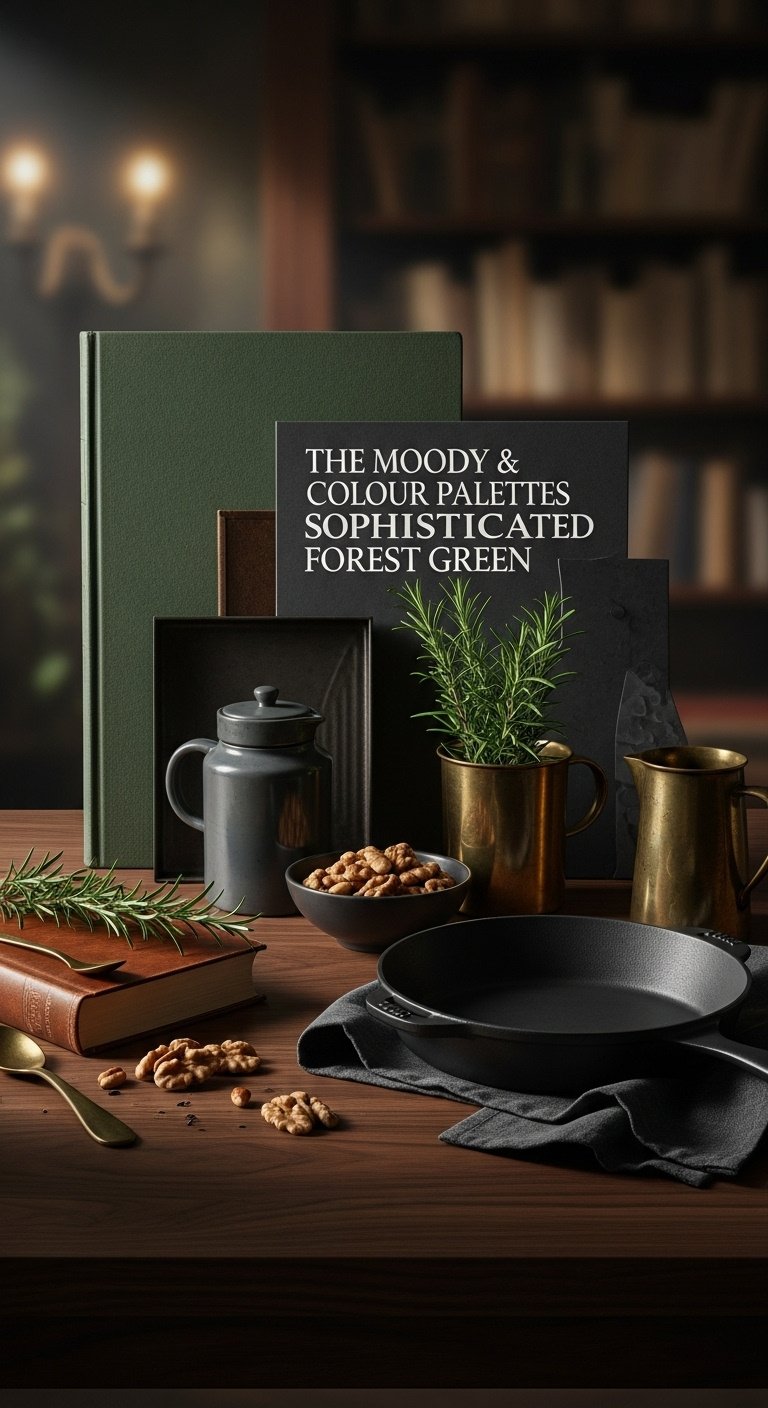
For those who crave drama and depth, a deep forest green kitchen is a stunning choice. It’s bold yet classic, creating a space that feels cozy, luxurious, and enveloping. Paired with rich wood and warm metals, it feels like a sophisticated English library.
- Palette Recipe:
- Dominant (60%): Deep forest or hunter green (e.g., for all cabinetry).
- Secondary (30%): Warm white or light beige (e.g., for backsplash and walls to provide contrast).
- Accent (10%): Rich walnut wood (open shelves) and antique brass (hardware and lighting).
Pro-Tip: With a dark cabinet color, lighting is crucial. Plan for under-cabinet task lighting and statement pendants to ensure the space is functional and feels intentionally moody, not just dark.
Love a bold look? Save this sophisticated green palette!
4. The Modern & Edgy Black on Black
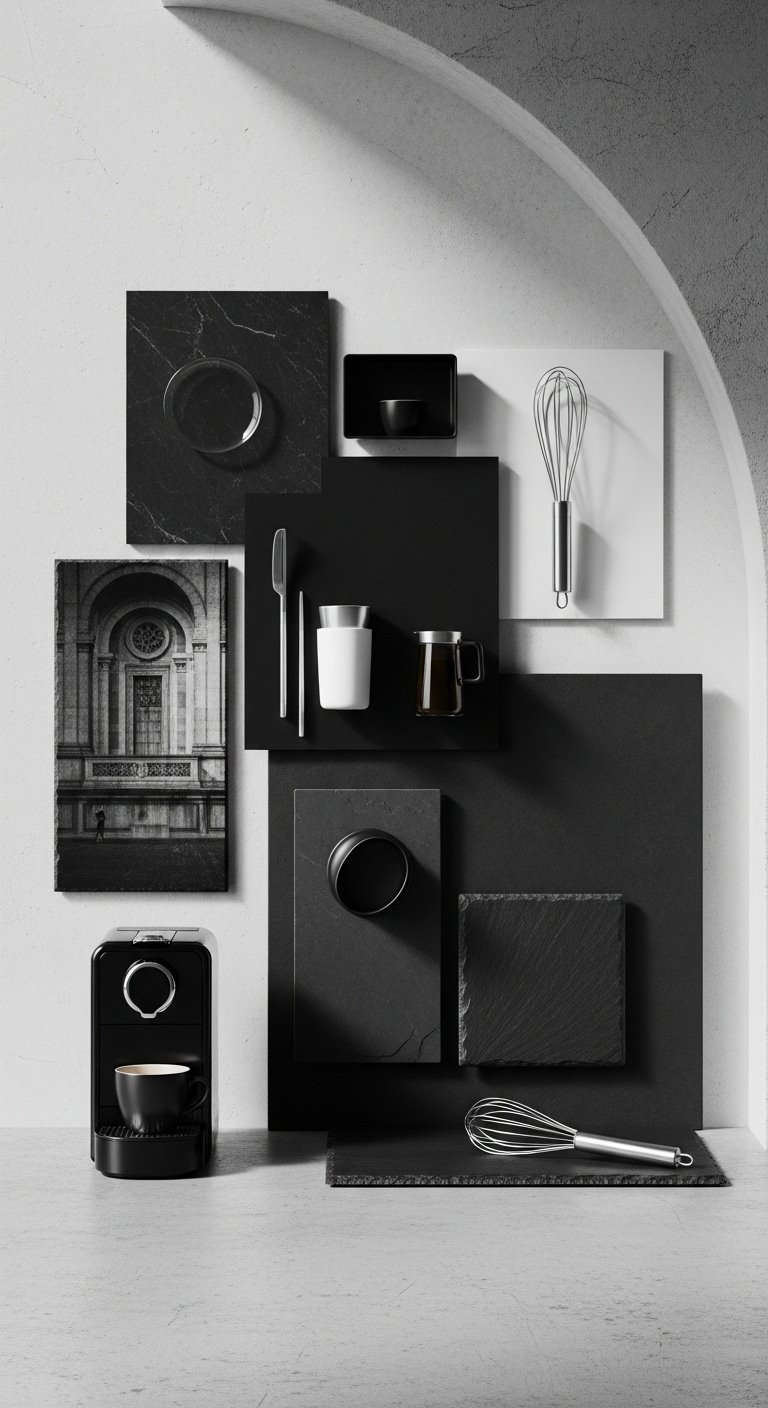
A black kitchen is the ultimate statement in modern design. It’s sleek, dramatic, and surprisingly versatile. The trick to making it work is to play with different textures to create depth and prevent the space from feeling flat or one-dimensional.
- Palette Recipe:
- Dominant (60%): Matte black (e.g., for flat-panel cabinets).
- Secondary (30%): Honed black or dark charcoal countertops (e.g., soapstone or quartz).
- Accent (10%): Natural wood tones (e.g., an oak island) and stainless steel (appliances, sink).
Lesson Learned: The key to a successful monochrome black kitchen is texture. Mix matte finishes on cabinets with the subtle veining of soapstone and the slight sheen of a tile backsplash to create visual interest and depth.
Dare to go dark? Pin this edgy black-on-black inspiration!
5. The Calm & Coastal Blue Grey
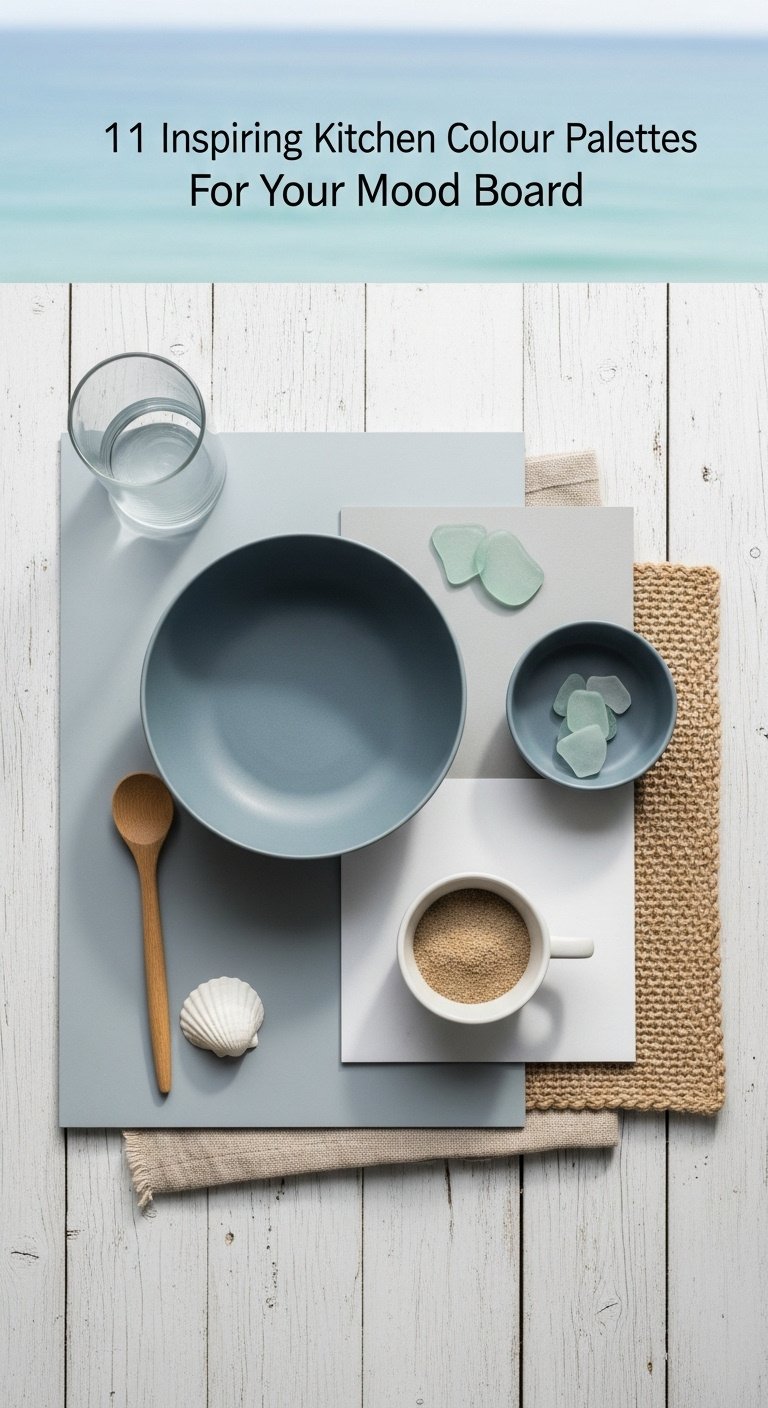
This palette evokes the feeling of a calm, misty morning by the sea. A dusty blue-grey is a sophisticated neutral that adds a touch of color without being overwhelming. It’s perfect for creating a serene and relaxing kitchen with a subtle coastal or modern farmhouse charm.
- Palette Recipe:
- Dominant (60%): Dusty blue-grey (e.g., for lower cabinets or island).
- Secondary (30%): Crisp, clean white (e.g., for upper cabinets, backsplash, and walls).
- Accent (10%): Sandy beige or light wood tones (flooring, stools) and brushed nickel (hardware).
Pro-Tip: Incorporate natural textures like jute rugs, rattan light fixtures, or linen roman shades to fully commit to the coastal aesthetic and add warmth.
Bring the beach home! Save this serene coastal palette.
6. The French Country Charm: Taupe & Cream
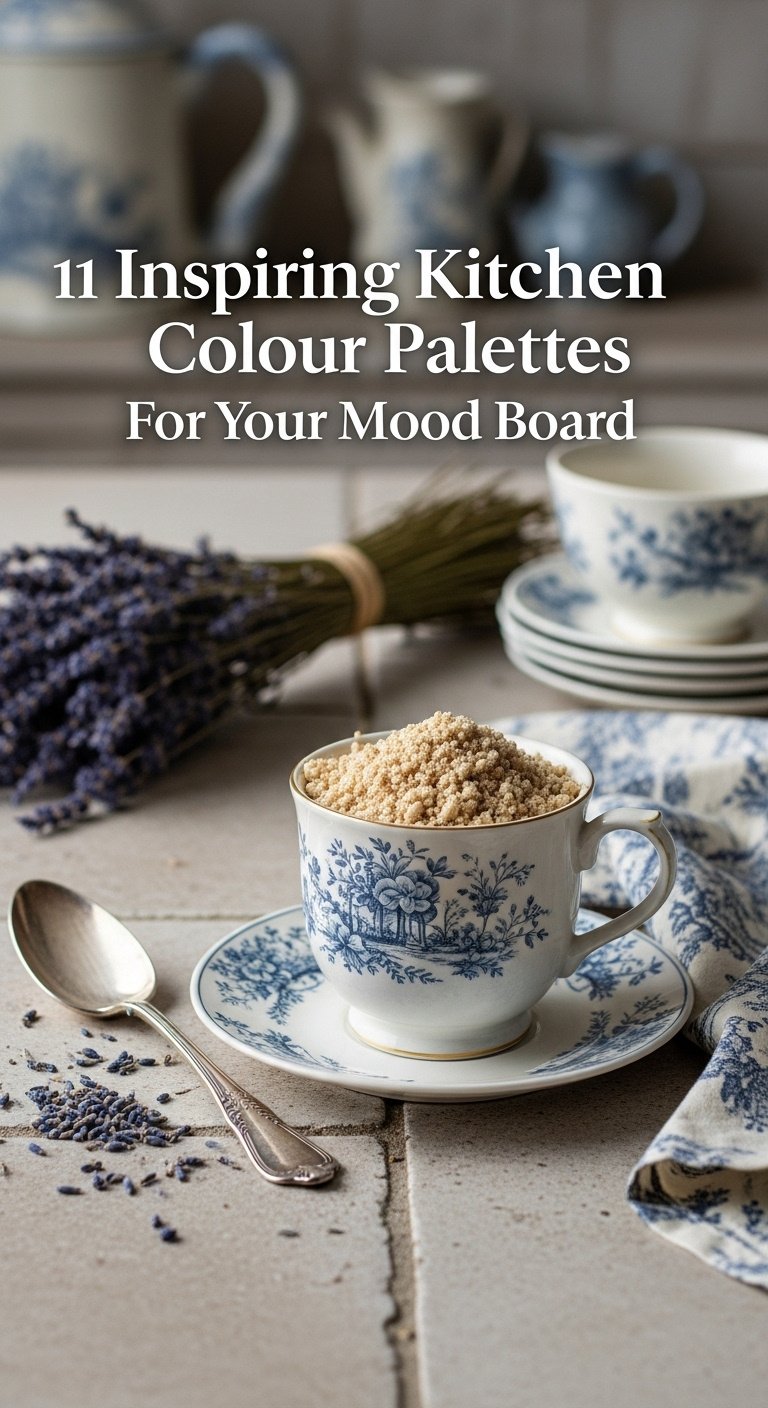
This palette transports you to a charming farmhouse in Provence. Warm taupe, a perfect blend of grey and beige, offers an elegance that is both rustic and refined. It creates a welcoming, lived-in atmosphere that feels timeless and full of character.
- Palette Recipe:
- Dominant (60%): Warm, grey-beige (taupe) (e.g., for detailed, shaker-style cabinets).
- Secondary (30%): Creamy off-white (e.g., for walls and a textured backsplash).
- Accent (10%): Weathered wood tones, aged brass hardware, and a hint of dusty French blue.
Lesson Learned: Authenticity is in the details. Look for cabinet hardware with an aged patina and consider a limestone or terracotta floor to ground the space in French country style.
Pin this for a touch of rustic European elegance!
7. The Cheerful & Modern: Bright Yellow Accent
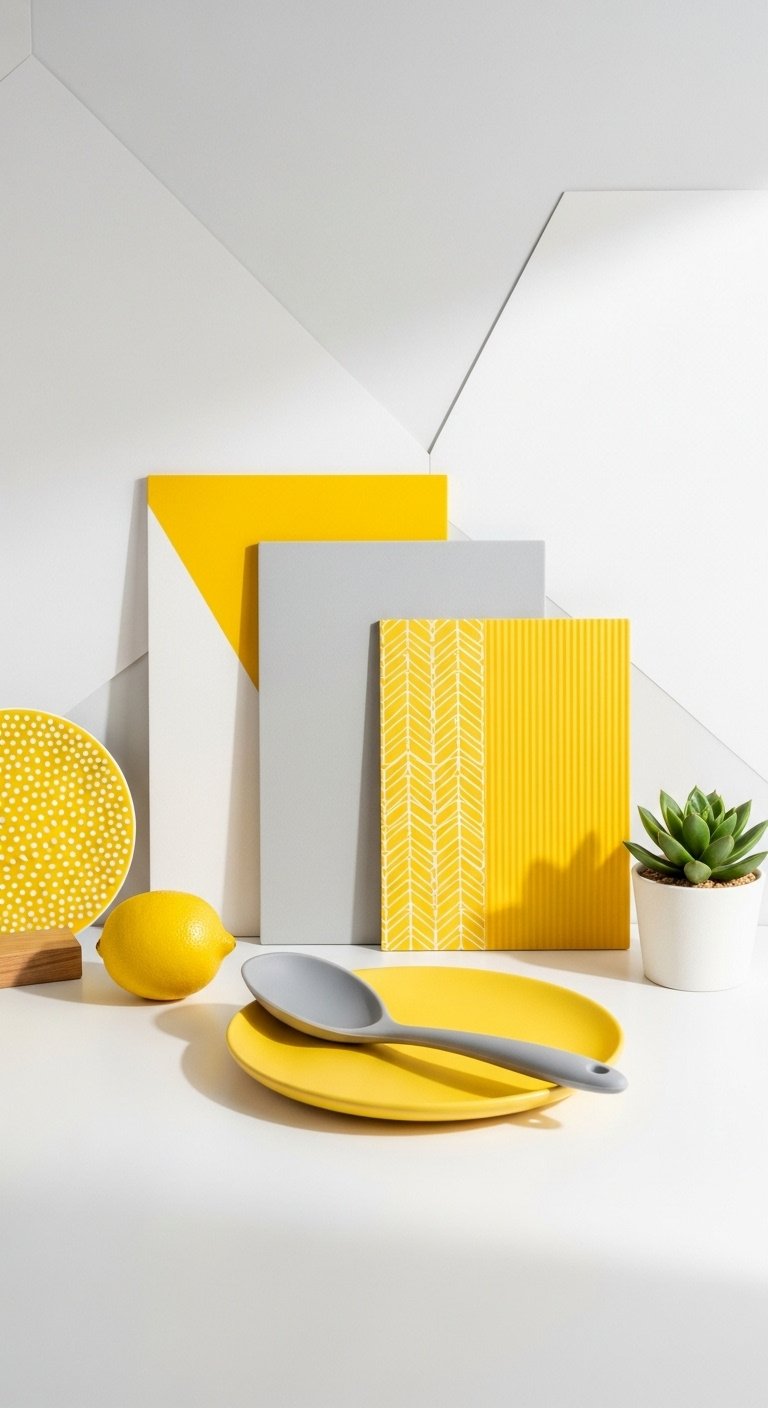
Want to start every day with a dose of happiness? A pop of bright yellow can instantly inject energy and optimism into your kitchen. When balanced with cool grey and crisp white, the look is modern and joyful, not overwhelming.
- Palette Recipe:
- Dominant (60%): Light, cool grey (e.g., for all cabinets).
- Secondary (30%): Crisp white (e.g., for walls and backsplash).
- Accent (10%): A single, bold stroke of bright yellow (e.g., the inside of a pantry, bar stools, or a statement appliance) and matte black hardware.
Pro-Tip: With a strong accent color, less is more. Start with small, easily changeable items like textiles or decor. If you love it, you can commit to painting an island or a single door.
Add a pop of sunshine! Save this cheerful yellow palette.

This palette is all about light, functionality, and natural beauty. Inspired by Nordic design, it combines pale wood tones with a whisper of icy blue for a look that is incredibly calming and clean. It’s perfect for minimalists who value simplicity and craftsmanship.
- Palette Recipe:
- Dominant (60%): Pure, gallery white (e.g., for walls and backsplash).
- Secondary (30%): Light birch or maple wood tones (e.g., for flat-panel cabinets or countertops).
- Accent (10%): A touch of icy, pale blue (e.g., on an island or a single wall) and stark matte black hardware.
Lesson Learned: Scandinavian design prioritizes function. Ensure the layout is efficient and storage is clever. The color palette should support, not overwhelm, the clean lines and natural materials.
For the minimalist at heart—pin this serene Scandi look!
9. The Bold & Beautiful Cobalt Blue
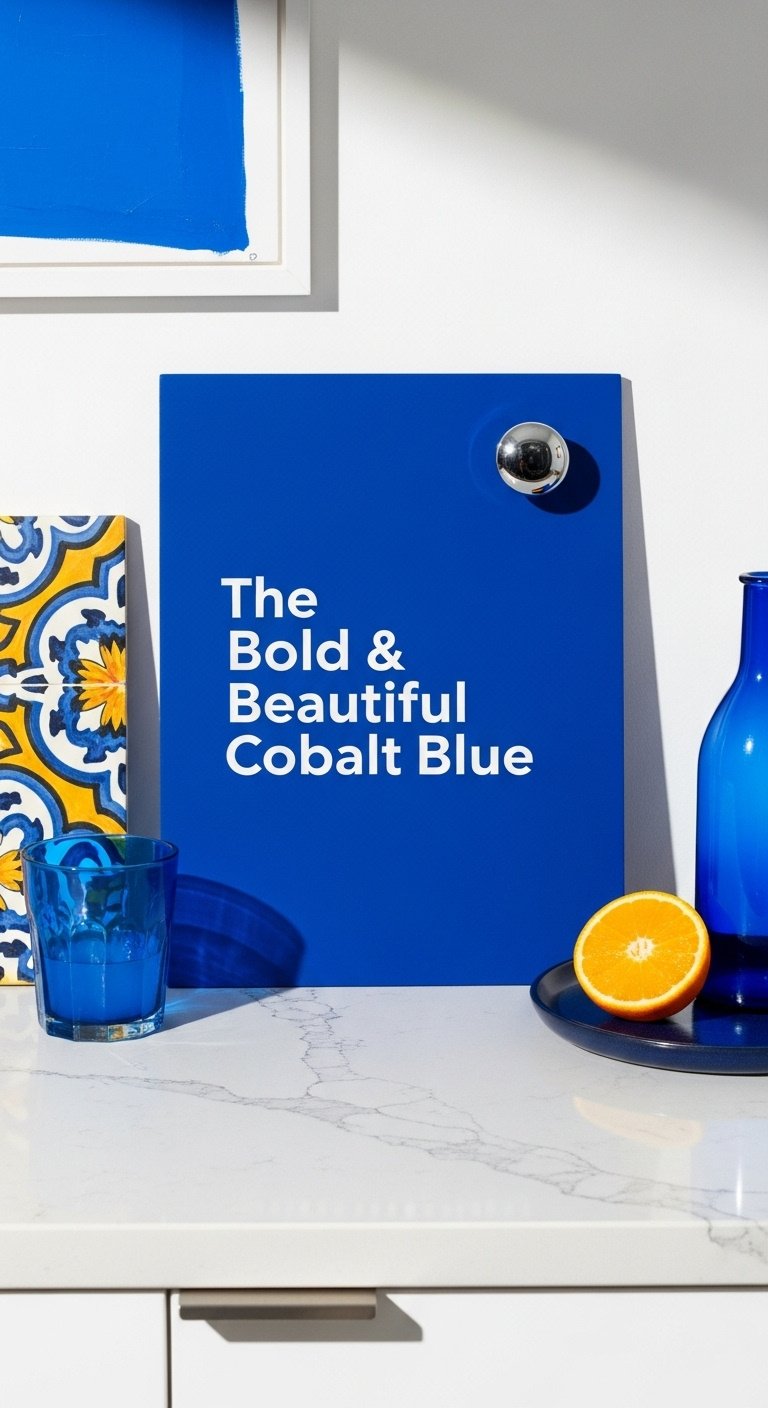
Confident, energetic, and undeniably chic. A saturated cobalt blue makes a powerful statement. When anchored by brilliant white, it feels fresh and modern, reminiscent of the Greek Isles. This is a choice for those who want their kitchen to be a vibrant conversation starter.
- Palette Recipe:
- Dominant (60%): Brilliant, clean white (e.g., for walls, backsplash, countertops).
- Secondary (30%): Saturated cobalt blue (e.g., for lower cabinets or a full pantry wall).
- Accent (10%): Polished chrome hardware and warm wood flooring to balance the cool tones.
Pro-Tip: To ground a vibrant blue, use a classic white quartz countertop with minimal veining. This provides a clean visual break and keeps the look feeling modern and fresh, not overwhelming.
Make a statement! Save this stunning cobalt blue kitchen idea.
10. The Modern Farmhouse: Greige & Matte Black
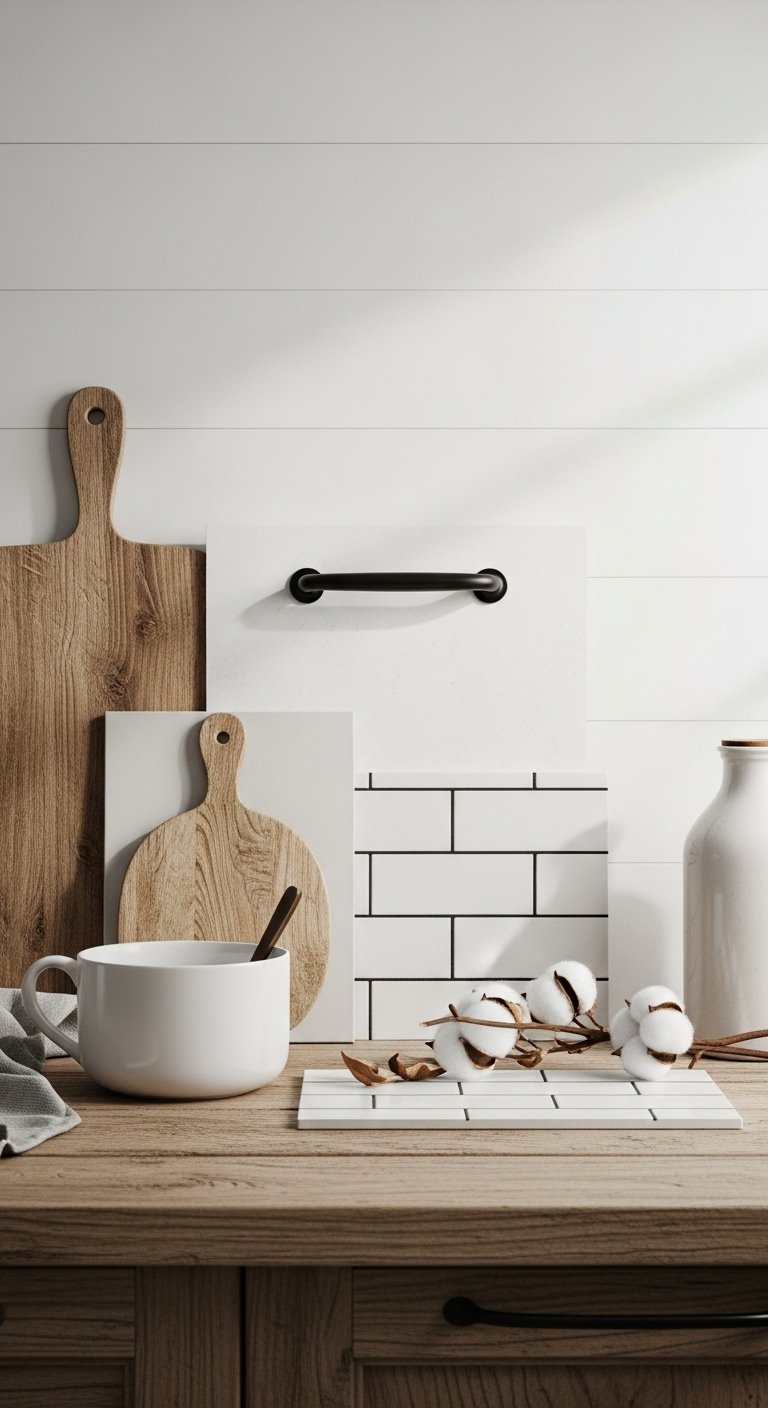
This is the perfect evolution of the classic farmhouse style. Greige—a sophisticated mix of grey and beige—offers warmth without being dated. Paired with high-contrast matte black and natural wood, the result is a kitchen that feels cozy, current, and comfortable.
- Palette Recipe:
- Dominant (60%): Warm greige (a mix of grey and beige) (e.g., for shaker cabinets).
- Secondary (30%): Soft, off-white (e.g., for walls and countertops).
- Accent (10%): Contrasting matte black (hardware, lighting) and warm, medium-toned wood.
Lesson Learned: The ‘modern’ in modern farmhouse comes from clean lines and high contrast. Use simple shaker cabinets, not overly ornate ones, and let the stark matte black hardware pop against the soft greige.
Get the perfect Modern Farmhouse look. Pin this palette!
11. The Playful Pastel Pop: Mint Green & Pink
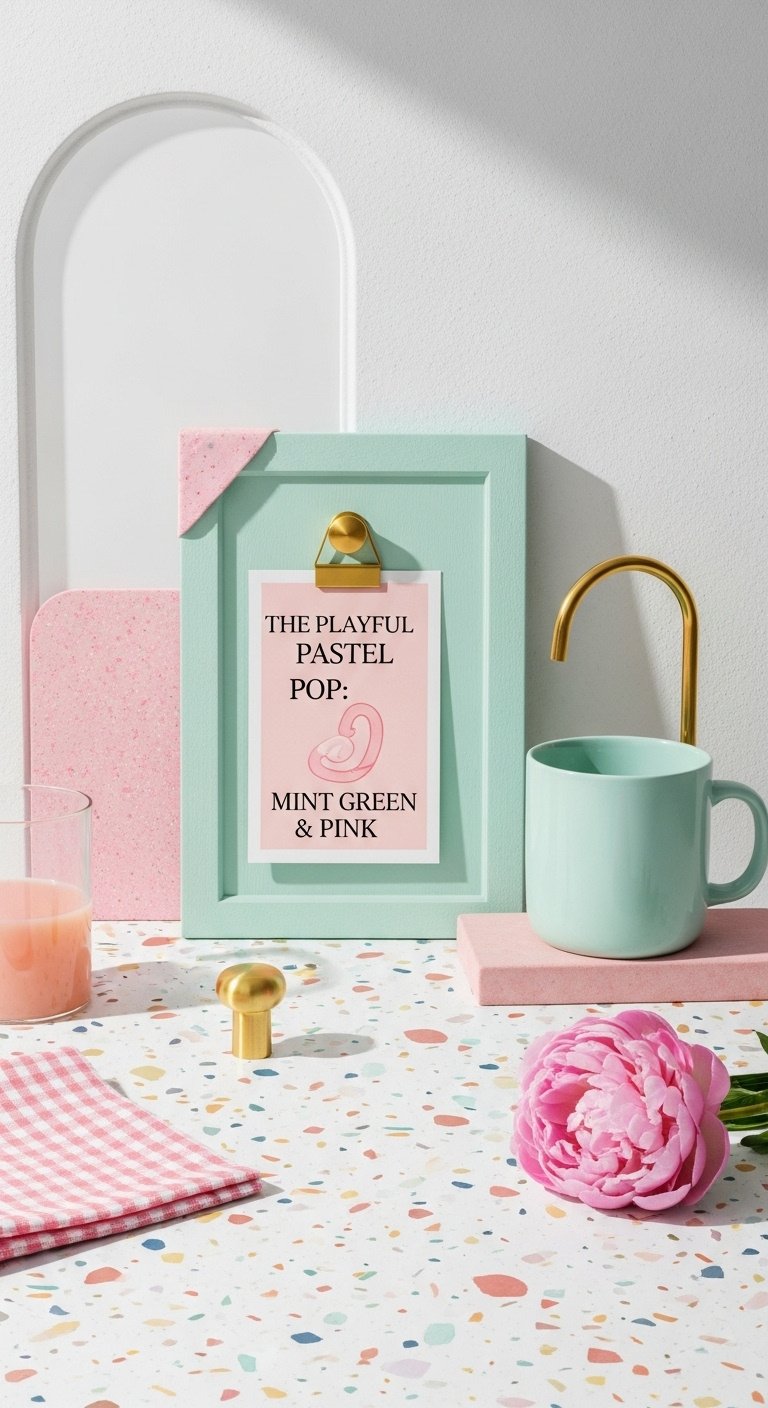
Who says kitchens have to be serious? This palette is for those who embrace color and want their space to reflect their fun-loving personality. Soft mint green paired with a touch of dusty rose creates a look that is whimsical, a little bit retro, and totally fresh.
- Palette Recipe:
- Dominant (60%): Soft mint green (e.g., for cabinetry).
- Secondary (30%): Crisp white (e.g., for walls and to balance the pastels).
- Accent (10%): Dusty rose pink (e.g., in a tiled backsplash or bar stools) and brushed gold hardware for a touch of glam.
Pro-Tip: To keep a pastel palette from looking too juvenile, ground it with a sophisticated material like a terrazzo countertop or sleek, modern gold hardware. It adds a layer of refinement to the playful colors.
Ready for some fun? Save this playful pastel kitchen idea!
Key Takeaways: Your Quick Guide to Kitchen Colour Palettes
- Start with a Mood Board: Always begin with a mood board to harmonize ideas, prevent costly mistakes, and clarify your vision.
- Use the 60-30-10 Rule: For a balanced look, apply this rule: 60% for your dominant color (like cabinets), 30% for a secondary color (walls/countertops), and 10% for an accent (hardware/decor).
- Embrace Warm Neutrals for 2025: Trends are moving towards warm, earthy tones like terracotta, sage, and beige for a grounded, calming atmosphere.
- Texture is Key: In any palette, especially monochrome or neutral ones, mix textures (matte, gloss, wood, stone) to create depth and visual interest.
- Don’t Fear Bold Color: Use vibrant colors as powerful accents on an island, a single wall, or in accessories for a high-impact, personality-filled space.
https://www.pinterest.com/pin/neutral-kitchen-design-inspiration–2040762328245212/
People Also Ask About Kitchen Colour Palettes
What is the 2025 color for kitchens?
For 2025, kitchen color trends are shifting towards warm neutrals and earthy, biophilic tones. Expect to see palettes centered around soft beige, terracotta, clay, and subtle olive or sage greens. These colors create a calming, grounded atmosphere that connects the kitchen to nature, moving away from the cooler grays of previous years.
What color kitchen never goes out of style?
A classic white kitchen is timeless and will never truly go out of style. Its versatility allows it to adapt to any design trend through changes in hardware, countertops, and decor. To ensure it feels warm and not sterile, opt for creamy off-whites instead of stark, cool whites and pair them with natural materials like wood and stone.
What is the rule for kitchen colors?
A widely used guideline is the 60-30-10 rule. This principle suggests that 60% of your space should be a dominant color (typically cabinets or walls), 30% should be a secondary color (countertops, flooring, or an island), and 10% should be an accent color (hardware, light fixtures, decor). This creates a visually balanced and harmonious space.
How do I make a mood board for a kitchen?
Start by gathering inspiration from sites like Pinterest and magazines. Then, collect physical or digital samples of your core elements: cabinet color, countertop material, backsplash tile, and flooring. Add images of hardware, lighting, and appliances. Arrange them all on a physical poster board or in a digital tool like Canva to see how they work together.
Final Thoughts
Your kitchen is the heart of your home, and its color palette should be a reflection of you. Creating a mood board isn’t just a design step; it’s the process of turning a collection of ideas into a clear, confident vision. Use these palettes as a starting point, mix and match, and build a kitchen that you’ll love for years to come. What color palette are you dreaming of for your kitchen? Let us know in the comments below
